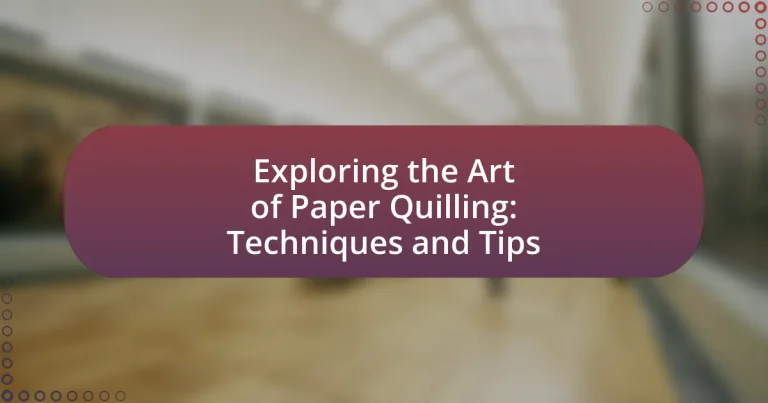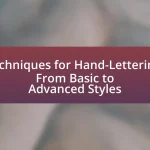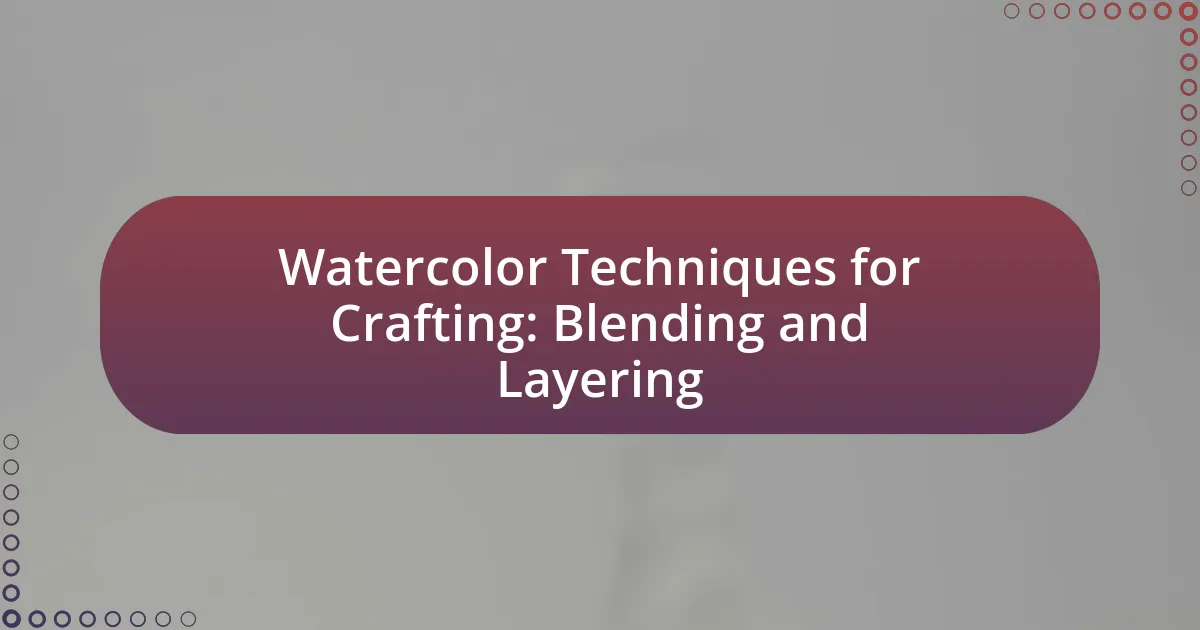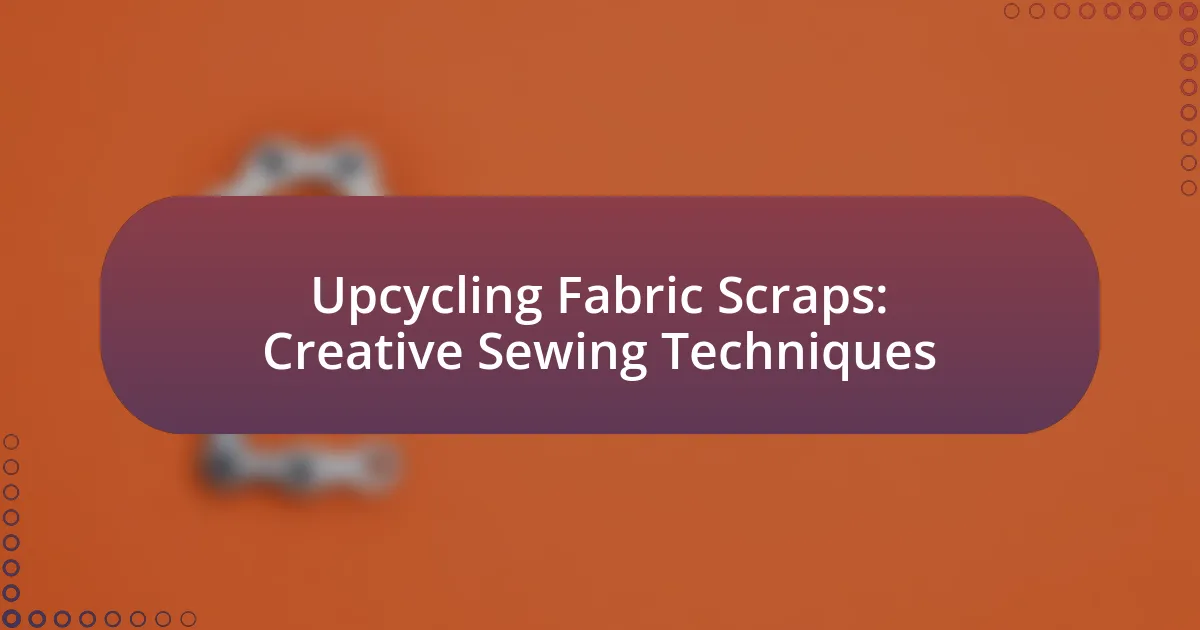Paper quilling is an intricate art form that involves rolling, shaping, and gluing strips of paper to create decorative designs, with origins tracing back to the Renaissance. This article explores the history, techniques, and materials associated with paper quilling, detailing its evolution from religious embellishments to contemporary decorative art. Key topics include the basic and advanced techniques of quilling, the benefits of engaging in this craft, and the social and educational aspects it fosters. Additionally, the article highlights the latest trends and practical tips for successful quilling, making it a comprehensive resource for both beginners and experienced artists.
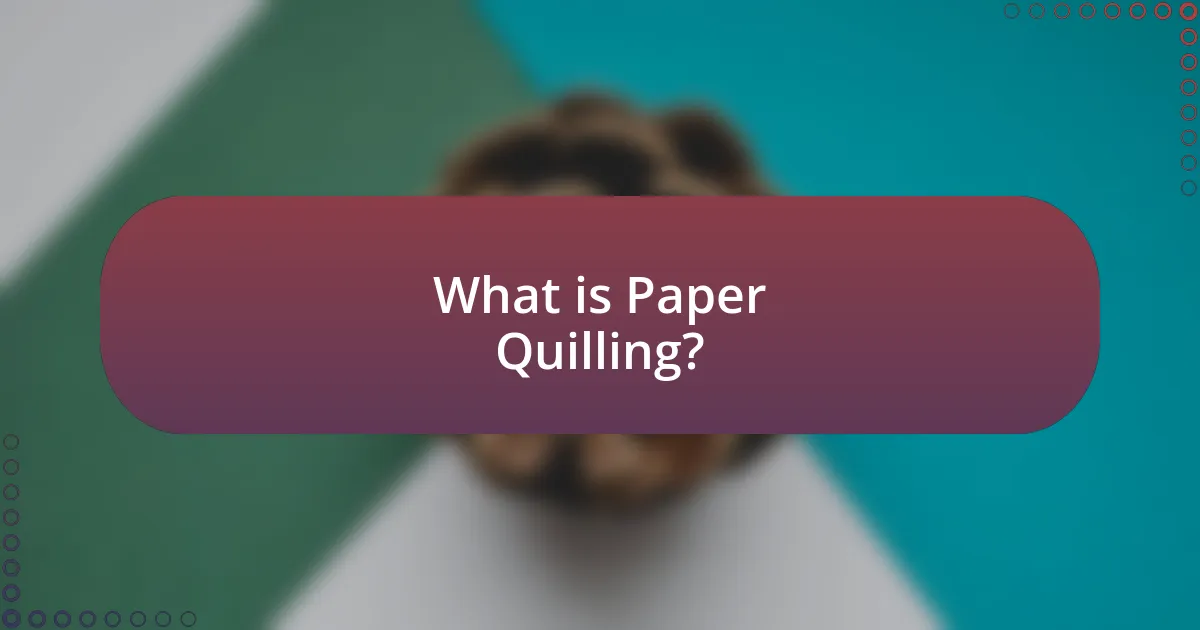
What is Paper Quilling?
Paper quilling is an art form that involves rolling, shaping, and gluing strips of paper to create decorative designs. This technique dates back to the Renaissance, where it was used to embellish religious artifacts and manuscripts. The process typically involves using a quilling tool to curl the paper strips into various shapes, which can then be combined to form intricate patterns and images. Historical evidence shows that quilling was popular among European nobility, highlighting its long-standing significance in decorative arts.
How did Paper Quilling originate?
Paper quilling originated in the 15th century, primarily in Europe, as a decorative art form using rolled and shaped strips of paper. Initially, it was practiced by nuns and monks who used paper strips to embellish religious artifacts and manuscripts. Historical evidence suggests that quilling became popular among the upper classes in the 18th century, where it was used to create intricate designs for home decor and personal items. The technique spread across Europe and evolved, leading to the diverse styles and applications seen in contemporary quilling today.
What historical contexts influenced the development of Paper Quilling?
The development of paper quilling was influenced by several historical contexts, particularly during the Renaissance and the 18th century. In the Renaissance, artists used quilling techniques to create intricate designs for religious artifacts and decorative items, utilizing strips of paper rolled and shaped into various forms. By the 18th century, quilling became popular among the upper classes in Europe, where it was often used to embellish furniture and create ornamental art, reflecting the era’s emphasis on craftsmanship and decorative arts. This historical significance is evidenced by surviving quilled pieces from that time, showcasing the artistry and cultural value placed on this craft.
Who were the pioneers of Paper Quilling?
The pioneers of paper quilling include artisans from the Renaissance period, particularly in Europe, where the craft gained popularity. Historical records indicate that nuns and monks used quilling to embellish religious artifacts and manuscripts, showcasing the technique’s early application in art and decoration. This practice evolved over time, leading to the development of intricate designs and patterns that characterize modern quilling.
What materials are used in Paper Quilling?
The primary materials used in paper quilling are strips of paper, a quilling tool, adhesive, and scissors. Strips of paper, typically 1/8 inch wide, can be made from various types of paper, including colored paper, cardstock, or specialty quilling paper, which is designed for flexibility and ease of use. A quilling tool, often a slotted tool or needle tool, is essential for rolling and shaping the paper strips. Adhesive, such as glue or a glue pen, is necessary for securing the shapes in place. Scissors are used for cutting the paper strips to the desired length. These materials collectively enable the creation of intricate designs and shapes in the art of paper quilling.
What types of paper are best for Quilling?
The best types of paper for quilling are lightweight, flexible papers such as quilling paper strips, cardstock, and specialty papers like mulberry or handmade paper. Quilling paper strips are specifically designed for this craft, typically measuring 1/8 inch wide and available in various colors, making them ideal for intricate designs. Cardstock provides sturdiness and can hold shapes well, while mulberry and handmade papers offer unique textures and colors that enhance the visual appeal of quilled projects. These paper types ensure ease of manipulation and durability, which are essential for successful quilling.
How do tools enhance the Paper Quilling process?
Tools enhance the Paper Quilling process by providing precision, efficiency, and versatility in creating intricate designs. Quilling tools such as slotted tools, tweezers, and scissors allow for more accurate rolling and shaping of paper strips, which results in cleaner and more defined shapes. For instance, a slotted tool enables consistent rolling of paper strips, reducing the likelihood of uneven edges, while tweezers facilitate the placement of delicate pieces without damaging them. Additionally, specialized tools like quilling boards and combs help in achieving uniform sizes and patterns, which is essential for complex designs. The use of these tools not only streamlines the quilling process but also enhances the overall quality of the finished artwork.
What are the basic techniques of Paper Quilling?
The basic techniques of paper quilling include rolling, pinching, shaping, and gluing strips of paper to create intricate designs. Rolling involves twisting a strip of paper around a quilling tool to form a coil, which can then be pinched to create various shapes like teardrops or leaves. Shaping refers to manipulating the coils into specific forms, while gluing secures the pieces together to maintain the design’s integrity. These foundational techniques are essential for creating detailed quilled artwork, as they allow for a variety of shapes and patterns that can be combined in numerous ways.
How do you create basic shapes in Paper Quilling?
To create basic shapes in Paper Quilling, you start by rolling strips of paper into coils, which can then be shaped into various forms. For example, to make a circle, tightly roll a strip and secure it with glue; for a teardrop shape, pinch one end of a rolled coil while keeping the other end round. These techniques allow for the formation of shapes such as circles, squares, and teardrops, which are foundational in quilling designs. The accuracy of these methods is supported by the fact that quilling has been practiced for centuries, with documented techniques dating back to the Renaissance, demonstrating their effectiveness in creating intricate designs.
What are the common techniques used in advanced Paper Quilling?
Common techniques used in advanced Paper Quilling include tight coils, loose coils, scrolls, and fringed shapes. Tight coils are created by rolling paper strips tightly around a tool, resulting in a dense, circular shape. Loose coils involve rolling the paper less tightly, allowing for a wider, more open form. Scrolls are formed by curling the ends of a coil in opposite directions, creating a spiral effect. Fringed shapes are made by cutting slits into a strip of paper before rolling, resulting in a textured appearance. These techniques enable artists to create intricate designs and detailed compositions, showcasing the versatility and depth of Paper Quilling as an art form.
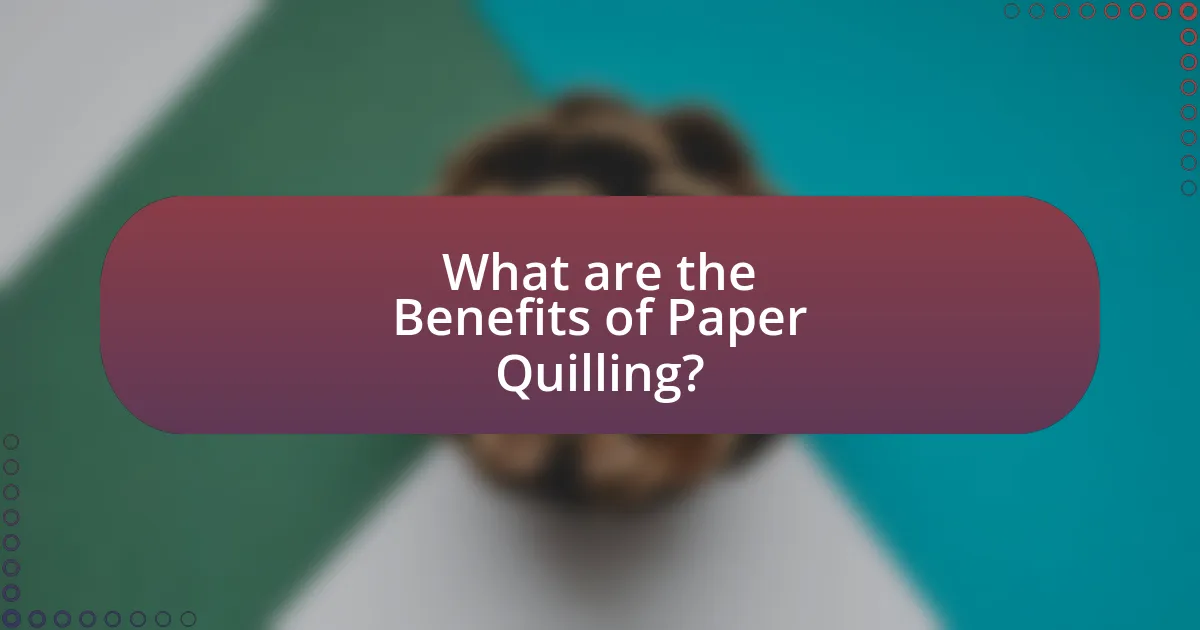
What are the Benefits of Paper Quilling?
The benefits of paper quilling include enhanced creativity, improved fine motor skills, and stress relief. Engaging in paper quilling stimulates the brain’s creative centers, allowing individuals to express their artistic vision through intricate designs. Additionally, the precise movements required in quilling help develop fine motor skills, which are essential for tasks that involve hand-eye coordination. Studies have shown that creative activities like paper quilling can also reduce stress and promote relaxation, making it a therapeutic hobby for many.
How does Paper Quilling promote creativity?
Paper quilling promotes creativity by encouraging individuals to manipulate strips of paper into intricate designs, fostering artistic expression. This craft requires problem-solving skills as artists envision and execute their designs, which enhances cognitive flexibility. Additionally, the variety of shapes, colors, and patterns available in quilling allows for personal interpretation and innovation, leading to unique creations. Studies have shown that engaging in artistic activities like paper quilling can improve overall creativity by stimulating the brain’s creative pathways, thus reinforcing the connection between hands-on crafting and imaginative thinking.
What skills can be developed through Paper Quilling?
Paper quilling develops several skills, including fine motor skills, creativity, and patience. Fine motor skills are enhanced as individuals manipulate small strips of paper, requiring precision and control. Creativity is fostered through the design process, allowing for unique artistic expression. Patience is cultivated as quilling often involves intricate and time-consuming work, teaching individuals to focus and persist through challenges. These skills are beneficial not only in art but also in various aspects of life, promoting dexterity, innovative thinking, and resilience.
How does Paper Quilling serve as a form of relaxation?
Paper quilling serves as a form of relaxation by engaging the mind and hands in a repetitive, creative process that promotes mindfulness. This artistic activity requires focus on intricate designs, which can distract from stressors and induce a meditative state. Research indicates that engaging in crafts like paper quilling can lower cortisol levels, the hormone associated with stress, thereby enhancing overall well-being. Additionally, the tactile nature of manipulating paper strips fosters a sense of accomplishment and satisfaction, further contributing to relaxation.
What social aspects are associated with Paper Quilling?
Paper quilling is associated with various social aspects, including community building, creative expression, and therapeutic benefits. Engaging in paper quilling often fosters social connections as individuals participate in workshops or group activities, enhancing interpersonal relationships. Additionally, the art form serves as a medium for creative expression, allowing individuals to share their unique perspectives and ideas through intricate designs. Research indicates that engaging in artistic activities like paper quilling can also provide therapeutic benefits, reducing stress and promoting mental well-being, which further encourages social interaction among participants.
How can Paper Quilling foster community engagement?
Paper quilling can foster community engagement by providing a collaborative platform for individuals to come together and create art. Workshops and community events centered around paper quilling encourage participation, skill-sharing, and social interaction among diverse groups. For instance, community centers and art organizations often host quilling classes that not only teach the technique but also promote teamwork and creativity, leading to stronger community bonds. Studies have shown that engaging in art activities can enhance social connections and improve mental well-being, further validating the role of paper quilling in building community ties.
What role does Paper Quilling play in educational settings?
Paper quilling plays a significant role in educational settings by enhancing fine motor skills and fostering creativity among students. Engaging in paper quilling activities requires precise hand movements, which help improve dexterity and coordination. Additionally, the artistic nature of quilling encourages students to express their creativity, allowing them to explore design concepts and color theory. Research indicates that hands-on art activities, such as paper quilling, can lead to improved cognitive development and problem-solving skills in children, making it a valuable tool in educational curricula.
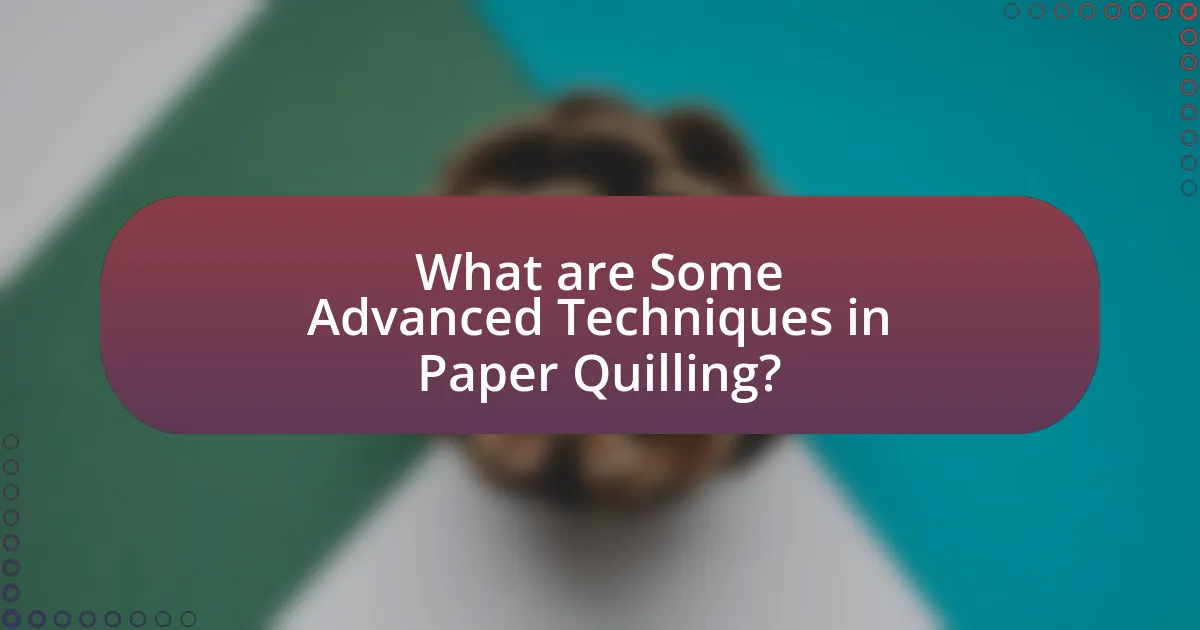
What are Some Advanced Techniques in Paper Quilling?
Some advanced techniques in paper quilling include 3D quilling, where strips are shaped into three-dimensional forms, and quilled filigree, which involves intricate designs using tightly and loosely rolled strips. Additionally, advanced artists often utilize techniques like quilled mosaics, where multiple quilled pieces create a larger image, and combining quilling with other crafts, such as painting or embroidery, to enhance visual appeal. These techniques require a high level of skill and precision, allowing for more complex and detailed artwork.
How can you incorporate mixed media into Paper Quilling?
To incorporate mixed media into paper quilling, artists can combine quilled elements with materials such as fabric, beads, or paint. This approach enhances the visual texture and depth of the artwork. For instance, adding fabric backgrounds or using beads as embellishments alongside quilled shapes creates a dynamic contrast. Additionally, applying paint to quilled pieces can introduce color gradients and effects that are not achievable with paper alone. This technique has been utilized in various art forms, demonstrating that mixed media can elevate traditional quilling by integrating diverse materials for a richer artistic expression.
What materials complement Paper Quilling effectively?
Cardstock, glue, scissors, and tweezers effectively complement paper quilling. Cardstock provides a sturdy base for quilled designs, while glue is essential for securing the paper strips in place. Scissors are necessary for cutting the strips to the desired length, and tweezers assist in handling small pieces with precision. These materials are commonly used in quilling projects, ensuring that the final artwork is both durable and visually appealing.
How does mixed media enhance the visual appeal of Quilling projects?
Mixed media enhances the visual appeal of Quilling projects by introducing diverse textures, colors, and materials that complement the intricate paper strips. The combination of elements such as beads, fabric, or paint can create depth and dimension, making the final artwork more engaging. For instance, incorporating metallic or glitter paper can add a shimmering effect, while using textured backgrounds can provide contrast that highlights the delicate quilled shapes. This layering of materials not only enriches the aesthetic but also allows for greater creative expression, as artists can experiment with various combinations to achieve unique visual outcomes.
What are some unique styles of Paper Quilling?
Some unique styles of Paper Quilling include 3D Quilling, where quilled shapes are layered to create depth; Fringe Quilling, which utilizes fringed strips for textured designs; and Quilled Portraits, where intricate quilled pieces form lifelike images. Each style showcases the versatility of quilling techniques, allowing artists to express creativity through various forms and dimensions. For instance, 3D Quilling often involves rolling strips into shapes that can be stacked or arranged to create a three-dimensional effect, enhancing visual interest.
How do different cultural influences shape Paper Quilling styles?
Different cultural influences shape Paper Quilling styles by introducing unique patterns, color palettes, and techniques that reflect the traditions and aesthetics of various societies. For instance, in India, quilling often incorporates vibrant colors and intricate designs that are inspired by local art forms, such as Mehndi and traditional textiles. In contrast, European quilling styles may emphasize delicate, pastel colors and floral motifs, drawing from historical art movements like Rococo. Additionally, cultural events and festivals can inspire specific themes in quilling, such as the use of symbols and motifs that are significant in particular cultures, thereby enriching the diversity of quilling styles globally.
What are the latest trends in Paper Quilling design?
The latest trends in Paper Quilling design include the use of mixed media, intricate 3D designs, and the incorporation of vibrant color palettes. Mixed media combines quilling with other art forms, such as watercolor or digital art, enhancing visual appeal. Intricate 3D designs are gaining popularity as artists create layered and dimensional pieces, moving beyond traditional flat quilling. Additionally, vibrant color palettes are being embraced, with artists experimenting with bold and contrasting colors to create eye-catching works. These trends reflect a shift towards innovation and creativity within the paper quilling community.
What are some practical tips for successful Paper Quilling?
To achieve successful paper quilling, start by using high-quality paper strips that are cut evenly, as this ensures uniformity in your designs. Additionally, maintaining a steady hand while rolling the strips is crucial for creating tight and consistent coils. Using a quilling tool, such as a slotted tool or needle tool, can enhance precision and ease in shaping the paper. It’s also beneficial to experiment with different shapes and sizes of coils to expand your creative options. Finally, securing your quilled pieces with a strong adhesive will ensure durability and stability in your projects.
How can beginners avoid common mistakes in Paper Quilling?
Beginners can avoid common mistakes in paper quilling by practicing proper rolling techniques and using the right tools. Ensuring that strips of paper are rolled tightly and evenly prevents gaps and inconsistencies in the design. Additionally, using a quilling tool designed for this purpose, rather than improvised tools, enhances precision and control. Beginners should also familiarize themselves with basic shapes and their applications, as understanding these foundational elements reduces errors in assembly. Lastly, taking time to plan the layout before gluing pieces together minimizes the risk of misalignment, which is a frequent issue for novices.
What resources are available for learning Paper Quilling techniques?
Resources for learning Paper Quilling techniques include online tutorials, instructional books, and video courses. Websites like YouTube offer numerous free video tutorials that demonstrate various quilling techniques, while platforms such as Skillshare and Udemy provide structured courses for a fee. Additionally, books like “Paper Quilling: A Beginner’s Guide” by K. M. K. and “The Art of Paper Quilling” by Susan M. are excellent resources that cover fundamental techniques and advanced projects. These resources collectively offer a comprehensive approach to mastering Paper Quilling.
